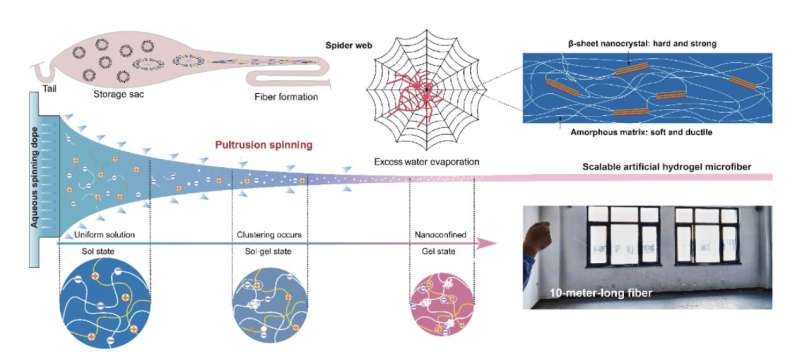Inspired by Spider Silk: Hydrogel Microfibers with Self-Healing and Crack-Resistance Properties

May 19, 2023 feature
This article has been reviewed according to Science X's editorial process and policies. Editors have highlighted the following attributes while ensuring the content's credibility:
- fact-checked
- peer-reviewed publication
- trusted source
- proofread
by Ingrid Fadelli , Tech Xplore
In recent years, material scientists have been creating new materials with a variety of advantageous properties that could enhance the performance of different technologies and devices. This includes hydrogel-based fibers and artificial skins, which could help to create soft humanoid robots, prosthetics, and even comfortable smart clothes or wearable devices.
Researchers at Donghua University in China recently created new hydrogel-based microfibers that are robust, self-healable and crack-resistant. These microfibers, introduced in Nature Communications, were fabricated using a process inspired by how spiders spin their webs.
'We noticed that although plenty of synthetic hydrogel fibers have been synthesized to mimic the basic functions of biological fibers like silk, muscle, and nerve fibers, most of them have very poor damage resistance, which greatly limits their durability,' Shengtong Sun, one of the researchers who carried out the study, told Tech Xplore. 'This may be solved by learning the structure of spider silk, which represents almost the limit of toughness of known natural biological materials.'
Spiders spin very strong silk webs from an aqueous dope, a liquid crystalline solution in which protein molecules can move freely while retaining some degree of order. The webs they create follow a hierarchical nanoconfined structure with advantageous mechanical properties.
'We envisaged that the ionic complex of a hygroscopic, positively charged polyelectrolyte (PDMAEA-Q) and polymethacrylic acid (PMAA) could be an ideal system to produce damage-tolerant hydrogel fibers.' Sun explained. 'In the formed fiber, PMAA would form strong hydrogen bonded clusters embedded in the soft matrix of ionic complexes. This could theoretically mimic the nanoconfined structure of spider silk for an improved mechanical performance.'
The researchers' hydrogel microfibers were produced under ambient conditions, just as those in which spiders produce their web. They used a technique known as pultrusion spinning to form the fibers from an aqueous solution containing PMAA and PDMAEA-Q.
'The spontaneous nanoconfinement of PMAA chains (H-bonded clusters) naturally occurs during water evaporation as separated nanophases embedded in the soft PDMAEA-Q/PMAA matrix,' Sun said. 'Such a hierarchical nanoconfinement imparts hydrogel microfibers with very high mechanical properties. For example, the hydrogel fiber is rather robust with a high Young′s modulus of 428 MPa and elongation of 219%.'
In initial evaluations, the microfibers created by the researchers exhibited highly promising properties. For instance, they were found to have a high damping capacity and crack resistance, as well as a high sensitivity to moisture that allowed them to contract, retain specific shapes, and rapidly 'self-heal' when damaged.
'In general, the high mechanical properties demand strong covalent bonding while the rapid repairing capability requires highly dynamic networks, which are inherently contradictory,' Sun said. 'We tackle this issue by employing the spider silk-like nanoconfined structure. Importantly, this hierarchical structure forms spontaneously during water evaporation, avoiding the tedious and energy-cost steps for further treatment.'
The recent work by this team of researchers could soon inspire the production of other highly performing fibrous materials based on nanoconfined structures and similar spinning processes. In addition, the spider silk-inspired hydrogel microfibers they created could soon be applied and evaluated in real-world settings, for instance as the actuating fibers of prosthetic limbs or wearable devices.
'We have shown that hydrogel fibers with a nanoconfined structure can display very good properties, but the toughness of the fibers are not yet comparable to that of real spider silk,' Sun added. 'In the future, we will try to introduce even stronger nanocrystals as nanoconfinement for further improving the mechanical properties of hydrogel fibers.'
More information: Yingkun Shi et al, Aqueous spinning of robust, self-healable, and crack-resistant hydrogel microfibers enabled by hydrogen bond nanoconfinement, Nature Communications (2023). DOI: 10.1038/s41467-023-37036-4
© 2023 Science X Network




